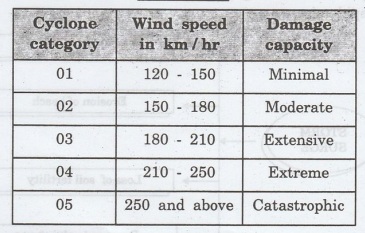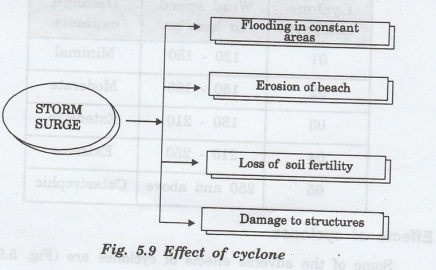Physics For Civil Engineering: Unit V: Natural Disasters
Cyclone Hazards
Definition, Types, Effects, Cyclone management | Natural Disasters
Cyclones are huge revolving storms in the atmosphere with very strong winds circulating round a central area. The word cyclone is derived from the Greek, word cyclos meaning the coils of a snake.
CYCLONE HAZARDS
Cyclones
Cyclones
are huge revolving storms in the atmosphere with very strong winds circulating
round a central area.
The
word cyclone is derived from the Greek, word cyclos meaning the coils of a
snake.
In
the northern hemisphere, a cyclone refers to an area of low atmospheric
pressure surrounded by winds moving in a counter-clockwise direction.
The
corresponding area of high atmospheric pressure with winds blowing in the
clockwise direction is called an anti-cyclone.
In the southern h hemisphere, the w wind
directions are reversed. The intensity of the cyclones and the strength of
winds depend on the amount of pressure drop in the centre and the rate of
increase of pressure outwards
Types of Cyclones
The
cyclones are classified as
(i) Extra tropical cyclones (or) temperature
cyclones
(ii) Tropical cyclones.
The
world meterological organisation uses the term 'Tropical cyclone' to cover
weather systems in which wind speed exceeds 63 km/hr.
Cyclones that develop in the regions
between the tropics of capricorn and cancer are called tropical cyclones.
Extra tropical cyclones occur in temperate zones and high latitude regions.
Categories
of cyclone based on wind speed
The
cyclones are classified into five different levels on the basis of wind speed
and their capacity to cause damage.

Effects of cyclones
Some
of the adverse effects of cyclones are (Fig. 5.9)
•
Cyclones are associated with high pressure gradients. Consequently they result
in strong winds which in turn generate storm surges.
•
This causes sea water to inundate low-lying area of coastal regions drowning
human beings and livestock.
•
A storm surge is an abnormal rise of sea level near the coast. This causes sea
water inundates low-lying areas of coastal region causing damage to human life
and property.
• The cyclones erode beaches and
embankments.
•
They
also destroy vegetation and reduces soil fertility. dgid bragg
• Very strong winds associated with cyclones may damage
installations, dwellings, communication systems, trees, etc., and resulting in
loss of life fe and property
•
Heavy
and prolonged rains due to cyclones lead to river floods and submergence of
low-lying areas.
•
Floods and coastal inundation due to storm surges pollute drinking water
sources causing outbreak of epidemics.

Cyclone management
Preventive
measures of cyclone
Cyclone
is a natural hazard and it is beyond human control. However, the damages caused
by these cyclones can be minimized by using the following measures:
• Planting more trees on the coastal belt
•
Construction of dams, storm shelter and wind breaks
•
Construction of proper drainage and wide roads for quick evacuation.
Forecasting
and Warning
•
Forecasting
a cyclonic event is the best measure of minimizing the losses due to a cyclone.
Advanced systems of cyclone forecasting are now available in almost all the
developed Nations of the world.
•
Warning should be issued immediately to the concerned government agencies and
to the general public.
Relief
tasks
•
Relief measures such as economic help and support by bloo to individuals,
community and government and non-governmental organizations should be ensured.
•
Awareness should be spread at all levels of the community to prepare everyone
for emergencies.
Physics For Civil Engineering: Unit V: Natural Disasters : Tag: : Definition, Types, Effects, Cyclone management | Natural Disasters - Cyclone Hazards
Related Topics
Related Subjects
Physics for Civil Engineering
PH3201 2021 Regulation | 2nd Semester Civil Dept 2021 Regulation
